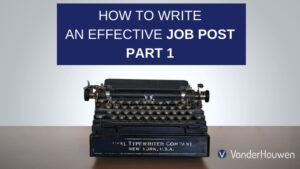How to Write an Effective Job Post: Part 2
This post is a continuation of our two-part blog series, How to Write an Effective Job Post. If you haven’t already, check out Part 1 here.
In part one of this two-part blog series on how to write an effective job post, we discussed how to convey your company’s mission and values with an attention grabbing introduction as well as how to effectively describe the position. In part 2, we’ll cover how to determine qualifications, do the appropriate research, and test for success.Determine the appropriate qualifications
Now that you’ve introduced your company, outlined the values of your business, and described the role, it’s time to address what you’re looking for in an ideal candidate. Note that the further we move down in the job description, the more specifically we focus on the candidate. The qualifications section focuses on what you’re looking for from the new hire—from education requirements to certifications to skills.Differentiate between required and preferred qualifications
You’ll want to break this section up into two parts—required qualifications and preferred qualifications. Required qualifications are the bare minimum of what a candidate must possess in order to be considered for the position; preferred qualifications are flexible, bonus qualifications that would be ideal but are negotiable. If you’re looking for a tax manager or an audit manager for a public company, a Certified Public Accountant (CPA) title will be a required qualification. But if it’s not a public company, put that under preferred qualifications. This is an important distinction. Brendan Browne, LinkedIn’s Head of Recruiting, has said that setting unrealistic expectations is one of the biggest mistakes hiring managers make. While we all want to find the ideal candidate, it’s important to not create a laundry list of requirements that will put off qualified candidates from even applying.Set a threshold for required education vs. relevant experience
Be sure to include how much work experience and what level of education is preferred for the role. For some positions, it may be worth quantifying how much relevant work experience would suffice for candidates without a degree qualification. For example, if you are looking to fill a support position, you could request that the candidate has an associate’s degree and/or a certain number of years of experience working in that field.Talk about soft skills
Remember that the appropriate credentials for a position go beyond technical qualifications. Too often, soft skills are not addressed in job descriptions. Soft skills can range from communication skills to conflict resolution to teamwork. For example, accountants are often investigators. If a CPA is auditing a company, he or she needs to be able to examine data, speak to staff and stakeholders, make judgments, and communicate delicately. For positions that support internal employees, like payroll, one needs skills in customer service, communication, and teamwork.Do your research
Feeling stuck? While it’s often the case that many companies have their job responsibilities and requirements completely spelled out, if you’re writing an ad for a brand new position, or if you find yourself hiring for a position that hasn’t needed to be filled for 10 years, here are a few tips.Talk to the department
The best way to get a sense of what a team needs from a new hire is to sit down with the key stakeholders and ask. You can ask a department head, or someone who works in a similar position as the one you’re hiring for, what the requirements are of the role. Ask what types of skills are relevant. Ask where their biggest needs lie. Get a thorough sense of what you’re looking for.Check out the competition
Take a look at the job boards of competitors to get a sense of what’s out there. This will provide inspiration not only on compelling copy, but can serve as a checklist to make sure you’re not missing any important keywords or skills in your job post. It’s sometimes the case that your team has one idea of how to describe a position, and then you find out that your competitors are using different (and better) keywords.Measure your success
Your job post is a living document. Be sure to test!
So you’ve finally finished writing your job post and sent it out the world—it’s on your company’s website, it’s on other platforms like Indeed and LinkedIn, you’ve been promoting the posting on your social media channels. Now is the time to monitor. Are you getting as many applicants as you expected? Are you getting the right kind of applicants? Are you noticing any patterns? If you’re not getting the results you need, it’s time to reexamine the job post and make sure everything is aligned. If you’ve received too few applicants, your required qualifications may be too extensive and discouraging. If your applicants aren’t quite fitting the profile you were hoping for, clarify and reexamine the keywords you used. Sometimes these discrepancies are easy to find—if your candidates aren’t matching education qualifications, that’s an easy fix to make in your job post. Other times, you’ll have to dig a little deeper and examine the language you use and the context you provide. Good luck! Remember, we’re always here to help you create a stellar job post. Reach out to one of our account managers for an in-depth consultation.Didn’t catch the beginning of this series? Here is Part 1 of How to Write an Effective Job Post.































































































































